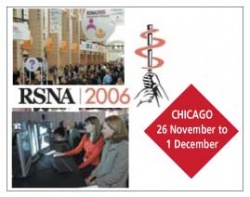90th RSNA Scientific Assembly
As information and communications technology (ICT) makes it way into the everyday practice of medicine, the Radiological Society of North America (RSNA) is integrating ICT with clinical presentations at the world's largest healthcare meeting this year.

This year’s meeting will do away with the free-standing info RAD display that has been a part of the congress for two decades. In its place, clinical informatics exhibits will be classified according to subspecialty or body organ, in a redesigned hall. ‘If it’s a CAD product, it’s going into the CAD area,’ said Betty Rohr, director of programme services for RSNA. This strategy, she explained, is the result of the RSNA board’s decision to change the name of the organisation’s Electronic Communications Committee to the Radiology Informatics Committee to reflect the fact that ICT is about so much more than just communications between clinicians.
Hall D, in the Lakeside Centre building at Chicago’s McCormick Place, has been dubbed the Lakeside Learning Centre. It will house 1,400 educational exhibits and more than 600 scientific posters, arranged as spokes on two wheels, according to subspecialty. Informatics displays will be interspersed in each ‘organ area’.
For the first time, RSNA will treat molecular imaging as a distinct subspecialty of radiology, with its own display area known as the Molecular Imaging Zone, set up around the perimeter of the Lakeside Learning Centre.
Betty Rohr added that the organisation has also noticed greater interest in teleradiology among its members.
Even with all this advanced technology, RSNA President Dr Robert Hatterly has chosen ‘Strengthening Professionalism’ as the theme of the 2006 assembly. As a practitioner and as current executive director of the American Board of Radiology, Dr Hatterly is a long-time advocate of continuous quality improvement.
One aspect of the professionalism theme is a 21st Century attempt to encourage colleagues to discuss and debate the poster presentations, as they used to congregate in hospitals. However, this time clinicians will be able to post their opinions on plasma displays – to create ‘collegiality’ Betty Rohr explained.
Cancer care is another area of emphasis. The RSNA is building a bit of a showcase around one of the scheduled speakers, Dr John E Niederhuber, acting director of the US government’s National Cancer Institute. RSNA officials said the institute is looking to get more practicing radiologists involved in clinical trials.
Through early October, the RSNA reported that 62,000 people had registered for the event, about 3% ahead of last year’s pace, and that hotel rooms were becoming scarce.
The nearly 700 commercial exhibitors will occupy 47,500m2 of the massive McCormick Place halls. Both numbers are reported to be about 7% higher than in 2005. Similar to the educational displays, exhibitors will be grouped by type of technology.
Report: Neil Versel
17.11.2006











